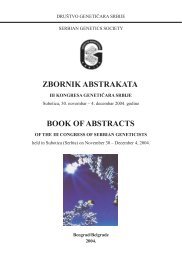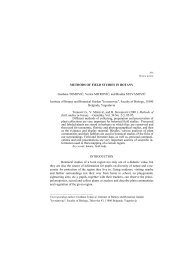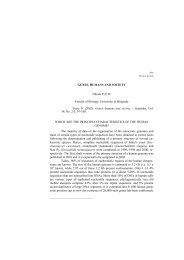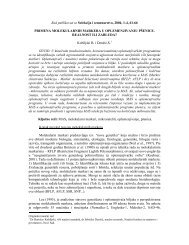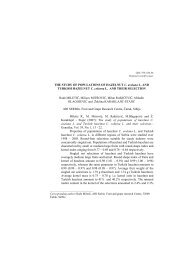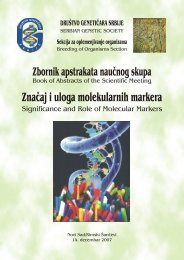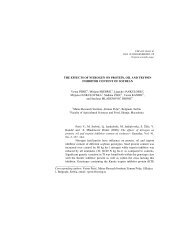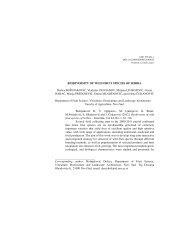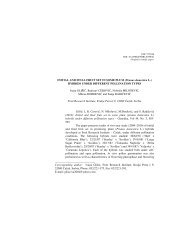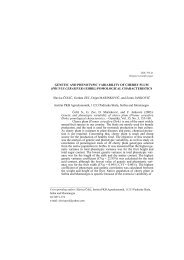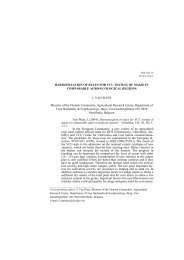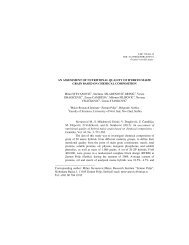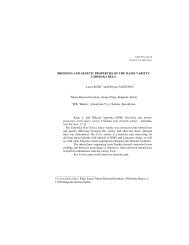Genetic divergence of Oblačinska sour cherry (Prunus cerasus L ...
Genetic divergence of Oblačinska sour cherry (Prunus cerasus L ...
Genetic divergence of Oblačinska sour cherry (Prunus cerasus L ...
Create successful ePaper yourself
Turn your PDF publications into a flip-book with our unique Google optimized e-Paper software.
UDC 575.21; 634.23<br />
Original scientific paper<br />
GENETIC DIVERGENCE OF OBLAČINSKA SOUR CHERRY (PRUNUS<br />
CERASUS L.) CLONES<br />
Dragan NIKOLIĆ, Vera RAKONJAC, Momčilo MILUTINOVIĆ, and Milica<br />
FOTIRIĆ<br />
Faculty <strong>of</strong> Agriculture, 11080 Belgrade-Zemun, Serbia and Montenegro<br />
Nikolić D., V. Rakonjac, M. Milutinović, and M. Fotirić (2005):<br />
<strong>Genetic</strong> <strong>divergence</strong> <strong>of</strong> oblačinska <strong>sour</strong> <strong>cherry</strong> (<strong>Prunus</strong> <strong>cerasus</strong> L.) clones.<br />
– Genetika, Vol. 37, No. 3, 191-198.<br />
Based on examination <strong>of</strong> 10 important pomologic and<br />
technologic properties, genetic <strong>divergence</strong> <strong>of</strong> 10 selected <strong>Oblačinska</strong> <strong>sour</strong><br />
<strong>cherry</strong> clones was established. The genetic <strong>divergence</strong> between the<br />
analyzed clones was determined using the hierarchical cluster analysis.<br />
The UPGA method was used and the Euclidean distance in order to<br />
determine the difference between the groups. Four similar clone groups<br />
were obtained on the dendrogram. The objective <strong>of</strong> clone differentiation<br />
was primarily yield, although other properties were taken into account as<br />
well. As the most yielded clones for the production, that can be<br />
recommended, were clone D8 or clone D4 that are genetically very<br />
similar, and clone D3.<br />
Key words: <strong>Oblačinska</strong> <strong>sour</strong> <strong>cherry</strong>, clone, cluster analysis<br />
INTRODUCTION<br />
<strong>Oblačinska</strong> <strong>sour</strong> <strong>cherry</strong> is our autochthonous cultivar that was named after<br />
the small village Oblačina in south Serbia. Considering other <strong>sour</strong> <strong>cherry</strong> cultivars<br />
in producing orchards it is represented with the largest number <strong>of</strong> trees. MIŠIĆ<br />
(1989) cited that existing <strong>Oblačinska</strong> <strong>sour</strong> <strong>cherry</strong> population was developed by<br />
_______________________________<br />
Corresponding author: Dragan Nikolić, Faculty <strong>of</strong> Agriculture, Nemanjina 6, 11080<br />
Belgrade-Zemun, Serbia and Montenegro, e-mail: nikolicd@agrifaculty.bg.ac.yu
192 GENETIKA, Vol. 37, No. 3, 191-198, 2005.<br />
vegetative reproduction mainly by shoots. Possibility that the generative<br />
reproduction influenced to wide spreading <strong>of</strong> this cultivar should not be excluded.<br />
All <strong>of</strong> that influenced the fact that <strong>Oblačinska</strong> <strong>sour</strong> <strong>cherry</strong> represents heterogeneous<br />
<strong>sour</strong> <strong>cherry</strong> population, a mixture <strong>of</strong> a great number <strong>of</strong> clones (genotypes).<br />
General characteristic <strong>of</strong> <strong>Oblačinska</strong> <strong>sour</strong> <strong>cherry</strong> is low vigor, small<br />
canopy habit, self-fertility and high and regular yields. Fruit is small (around 3 g),<br />
rotundas, with uniformly size and ripening time. Skin is dark red and thin. Fruit<br />
flesh is red, medium firm, juicy, with lots <strong>of</strong> acids, aromatic, high quality and<br />
suitable for processing in numerous products. Stalk is easily separated from the<br />
fruit and pyramidal shape <strong>of</strong> scaffolds is giving <strong>Oblačinska</strong> <strong>sour</strong> <strong>cherry</strong> special<br />
possibility for the mechanical harvesting (PAVIĆEVIĆ, 1976).<br />
While <strong>Oblačinska</strong> <strong>sour</strong> <strong>cherry</strong> is not pure cultivar but mixture <strong>of</strong> clones<br />
(genotypes), problems with its` reproduction and exploitation occur. Because <strong>of</strong><br />
those reasons, considering breeding methods, special attention should be pay to the<br />
clonal selection. With clonal selection should separate genotypes that, beside good<br />
yields, will have large fruits with high soluble solid and organic acid content and<br />
with different ripening time.<br />
Considering all <strong>of</strong> this, based on previously examined variability, in south<br />
Serbia producing orchards, 10 phenotypic different clones <strong>of</strong> <strong>Oblačinska</strong> <strong>sour</strong><br />
<strong>cherry</strong> were separated. While evaluation <strong>of</strong> clones suitable for further exploitation<br />
is done based <strong>of</strong> numerous desirable characteristics, in this paper, the hierarchical<br />
cluster analysis was used for determination <strong>of</strong> genetic <strong>divergence</strong> <strong>of</strong> separated<br />
clones. Divergence <strong>of</strong> clones was determined based on 10 most important<br />
pomologic and technologic properties. Besides establishing genetic variability, the<br />
most promising clones are recommended for further spreading in production.<br />
MATERIAL AND METHODS<br />
Investigation included 10 <strong>Oblačinska</strong> <strong>sour</strong> <strong>cherry</strong> clones selected from<br />
producing orchards <strong>of</strong> south Serbia. Selected clones were vegetative reproduced on<br />
rootstock <strong>Prunus</strong> mahaleb L. and planted at the Experimental Station<br />
“Radmilovac” <strong>of</strong> the Faculty <strong>of</strong> Agriculture in Belgrade. Planting <strong>of</strong> clones was<br />
done in 1994, on planting distance 4 x 3 m. During period 2000-2002, on sample <strong>of</strong><br />
three trees per each clone, following pomologic and technologic properties were<br />
examined: ripening time, yield, fruit weight, stone weight, randman, fruit stalk<br />
length, soluble solid content, total sugar content, invert sugar content and total acid<br />
content.<br />
Picking time was taken as ripening time. Yield per tree was determined by<br />
measuring all fruits from the tree. On 30 fruits, as sample, collected during full<br />
maturity, fruit weight, stone weight and fruit stalk length were measured.<br />
Randman, that represents percentage <strong>of</strong> fruit flesh in total fruit weight, was<br />
established calculating. Soluble solid content was determined by hand refractmeter,<br />
and total and invert sugar content after Somogy Nelson. Total acid content<br />
was established by titration with 0.1N NaOH.
D.NIKOLIĆ et al.: GENETIC DIVERGENCE OF CHERRY CLONES 193
194 GENETIKA, Vol. 37, No. 3, 191-198, 2005.<br />
For all examined characteristics, mean values were calculated for threeyears<br />
period <strong>of</strong> investigation. <strong>Genetic</strong> <strong>divergence</strong> between examined clones was<br />
determined by using the hierarchical cluster analysis. The UPGA method was used<br />
and the Euclidean distance in order to determine the difference between the groups.<br />
RESULTS AND DISCUSSION<br />
Fruits <strong>of</strong> all examined <strong>Oblačinska</strong> <strong>sour</strong> <strong>cherry</strong> clones averagely ripen, in<br />
all three years <strong>of</strong> the experiment, in first decade <strong>of</strong> June, in interval from 6 th June<br />
up to 9 th June (Table 1). OGAŠANOVIĆ et al. (1985) determined insignificantly<br />
exception <strong>of</strong> the ripening time, from one to two days, in 8 selected <strong>Oblačinska</strong> <strong>sour</strong><br />
<strong>cherry</strong> clones. From Table 1 can be seen that the lowest yield had clone D1 (5.1<br />
kg/tree), but the largest clone D8 (20.6 kg/tree). Clone D4 had the highest fruit<br />
weight (3.52 g), stone weight (0.33 g) and fruit stalk length (3.0 cm), while the<br />
lowest fruit weight (2.62 g) had clone D7, the lowest stone weight (0.25 g) clones<br />
D9 and D10, and the lowest fruit stalk length (2.4 cm) clones D3, D7 and D10.<br />
Similar varying intervals for fruit weight from 3.12 g up to 4.01g established<br />
MILUTINOVIĆ et al. (1980) in examined 6 <strong>Oblačinska</strong> <strong>sour</strong> <strong>cherry</strong> clones and<br />
OGAŠANOVIĆ et al. (1985), who cited that in 8 selected clones average fruit weight<br />
varied from 2.8 g up to 3.1 g. In contrast to the results <strong>of</strong> our paper, NIKOLIĆ et al.<br />
(1996) established significantly higher varying interval <strong>of</strong> the fruit stalk length in 6<br />
selected <strong>Oblačinska</strong> <strong>sour</strong> <strong>cherry</strong> clones that was between 2.36 cm and 4.46 cm.<br />
Although fruit <strong>of</strong> the <strong>Oblačinska</strong> <strong>sour</strong> <strong>cherry</strong>, considering other cultivars is much<br />
smaller, ratio between fruit flesh and stone in selected and examined clones in our<br />
investigations mostly was satisfied and was from 89.97% (clone D8) up to 91.29%<br />
(clone D10).<br />
PAVIĆEVIĆ (1976) cited that in dependence <strong>of</strong> the year, locality and<br />
picking time, soluble solid content in <strong>Oblačinska</strong> <strong>sour</strong> <strong>cherry</strong> is between 12% and<br />
17%, and total acid content from 1.4% up to 2.0%. MILUTINOVIĆ et al. (1980)<br />
established that in 6 examined <strong>Oblačinska</strong> <strong>sour</strong> <strong>cherry</strong> clones soluble solid content<br />
varied from 12.81% to 17.90%, and total acid content from 1.45% to 1.95%, while<br />
OGAŠANOVIĆ et al. (1985) cited that in 8 selected clones soluble solid content<br />
varied from 16.7% to 19.7%, and total acid content from 3.17% to 3.30%. Results<br />
in Table 1 are showing that in our paper varying interval <strong>of</strong> the soluble solid<br />
content in examined clones was from 15.96% (clone D8), up to 19.11% (clone<br />
D10), varying interval <strong>of</strong> the total sugar content from 7.38% (clone D4) to 9.28%<br />
(clone D5), and varying interval <strong>of</strong> the invert sugar content from 4.51 % (clone D2)<br />
up to 5.36% (clone D10). The lowest total acid content had clone D9 (1.06%) and<br />
the highest clone D2 (1.26%).<br />
Based on previously showed results can be noticed that all examined<br />
<strong>Oblačinska</strong> <strong>sour</strong> <strong>cherry</strong> clones differ in all investigated characteristics. However,<br />
on occasion <strong>of</strong> establishing genetic variability and estimation <strong>of</strong> the genotype<br />
suitability for growing or further breeding work, lot <strong>of</strong> characteristics should be<br />
parallely considered. Multivariational analysis and cluster analysis as one <strong>of</strong> them<br />
are methods suitable for establishing genetic distance <strong>of</strong> the examined material
D.NIKOLIĆ et al.: GENETIC DIVERGENCE OF CHERRY CLONES 195<br />
(LIN, 1982; RAMEY and ROSIELLE, 1983). VITKOVSKIJ et al. (1988) cited that<br />
values <strong>of</strong> examined properties in combination with multivariational analysis are<br />
performing good base for consolidate affinity <strong>of</strong> species and cultivars <strong>of</strong> the genus<br />
<strong>Prunus</strong>. So, HILLIG and IEZZONI (1988), by using multivariational analysis, based<br />
on 27 morphological properties, established origin and genetic affinity <strong>of</strong> 16 <strong>sour</strong><br />
<strong>cherry</strong> cultivars, and certain number <strong>of</strong> hybrids and seedlings obtained by open<br />
pollination.<br />
D1<br />
D7<br />
D9<br />
D2<br />
D6<br />
D5<br />
D10<br />
D3<br />
D4<br />
D8<br />
1<br />
2<br />
3<br />
4<br />
0 2 4 6 8 10<br />
Fig. 1. Dendrogram <strong>of</strong> phenotypic differences <strong>of</strong> <strong>Oblačinska</strong> <strong>sour</strong> <strong>cherry</strong> clones constructed<br />
based on 10 pomologic and technologic characteristics<br />
In our paper, based on mean value <strong>of</strong> all examined characteristics, by<br />
using hierarchical cluster analysis, dendrogram <strong>of</strong> the phenotypic differences <strong>of</strong> the<br />
examined <strong>Oblačinska</strong> <strong>sour</strong> <strong>cherry</strong> clones was constructed (Fig. 1). <strong>Oblačinska</strong> <strong>sour</strong><br />
<strong>cherry</strong> clones are connected on different ways, which shows existing <strong>of</strong> numerous<br />
hierarchical levels. Considering values <strong>of</strong> the Euclidean distance and grouping<br />
way, four groups <strong>of</strong> similar clones are separated. Clones D1, D7 and D9 make first<br />
group. Clones D1 and D7, that are in the same hierarchical level have low yield,<br />
low fruit weight and medium stone weight, satisfied randman and medium total<br />
acid content. Clone D9, which is connected with previous two clones on higher<br />
hierarchical level and belongs to the same group, differs from those two clones<br />
because it has lower stone weight and lower total acid content. Clones D2 and D6<br />
that are connected on the lowest hierarchical level together with clones D5 and<br />
D10 are making second group. Considering clones from the first group they have<br />
higher yields. In third group there is only D3 clone. Fourth group includes clones<br />
D4 and D8. Common for both clones is high yield and large fruit and stone.<br />
Exactly those three characteristics that make them differ from the other clones<br />
influenced their classification in a special group.<br />
By analysis <strong>of</strong> examined properties on grouping investigated <strong>Oblačinska</strong><br />
<strong>sour</strong> <strong>cherry</strong> clones, can be concluded that the biggest influence had yield, but other<br />
12
196 GENETIKA, Vol. 37, No. 3, 191-198, 2005.<br />
characteristics should not be underestimate. RAKONJAC et al. (1996), by<br />
application <strong>of</strong> multivariational analysis established that on grouping <strong>of</strong> wild <strong>cherry</strong><br />
genotypes influenced numerous properties, but the most important were: yield,<br />
ripening time, juice color, tree shape and seed germination.<br />
For increasing genetic variability <strong>of</strong> <strong>Oblačinska</strong> <strong>sour</strong> <strong>cherry</strong> and<br />
preserving its germ plasma, based on results <strong>of</strong> cluster analysis obtained in our<br />
paper, it can be recommended that from each group one clone can be selected and<br />
collected. From the other side, clones D8 or D4 from forth group and clone D3<br />
from third group can be recommended for the production because they have high<br />
yields.<br />
CONCLUSION<br />
In examined <strong>Oblačinska</strong> <strong>sour</strong> <strong>cherry</strong> clones considerable variability <strong>of</strong><br />
analyzed pomologic and technologic properties have been established.<br />
Using hierarchical cluster analysis, four groups <strong>of</strong> similar clones are<br />
separated on obtained dendrogram. Three clones are in the first group, four in<br />
second, only one in third and two clones in fourth group.<br />
Separation <strong>of</strong> the clones in groups is primary because <strong>of</strong> the yield, but<br />
other characteristics influenced on separation as well.<br />
As the most yielded clones for the production, that can be recommended,<br />
were clone D8 or clone D4 that are genetically very similar, and clone D3.<br />
REFERENCES<br />
Received April 12 th , 2005<br />
Accepted June 1 st , 2005<br />
HILLIG K.W. and A.F. IEZZONI (1988): Multivariate analysis <strong>of</strong> a <strong>sour</strong> <strong>cherry</strong> germplasm collection.<br />
J. Amer. Soc. Hort. Sci., 113 (6), 928-934.<br />
LIN C.S. (1982): Grouping genotypes by a cluster method directly related to genotype-environment<br />
interaction mean square. Theor. Appl. Genet., 62, 277-280.<br />
MILUTINOVIĆ M., J. SIMONOVIĆ, and M. JOVANOVIĆ (1980): Proučavanje klonova Oblačinske<br />
višnje. Jugoslovensko voćarstvo, 14 (51-52), 109-113.<br />
MIŠIĆ D.P. (1989): Nove sorte voćaka. Nolit, Beograd.<br />
NIKOLIĆ D., V. RAKONJAC, M. MILUTINOVIĆ, and M.M. MILUTINOVIĆ (1996): Vrednovanje<br />
selekcionisanih klonova Oblačinske višnje. Jugoslovensko voćarstvo, 30 (115-116), 343-<br />
347.<br />
OGAŠANOVIĆ D., LJ. JANDA i J. GAVRILOVIĆ (1985): Uporedna proučavanja selekcionisanih<br />
klonova Oblačinske višnje. Jugoslovensko voćarstvo, 19 (71-72), 165-169.<br />
PAVIĆEVIĆ B. (1976): Karakteristike Oblačinske višnje. Jugoslovensko voćarstvo, 10 (37-38), 153-<br />
156.
D.NIKOLIĆ et al.: GENETIC DIVERGENCE OF CHERRY CLONES 197<br />
RAKONJAC V., G. ŠURLAN-MOMIROVIĆ, I. LJUBANOVIĆ-RALEVIĆ, N. RALEVIĆ, and M.<br />
MILUTINOVIĆ (1996): Morphological and biochemical variability in different populations<br />
<strong>of</strong> wild sweet <strong>cherry</strong> (<strong>Prunus</strong> avium L.). Acta Hort., 410, 413-421.<br />
RAMEY T.B. and A.A. ROSIELLE (1983): HASS cluster analysis: a new method <strong>of</strong> grouping<br />
genotypes or environments in plant breeding. Theor. Appl. Genet., 66, 131-133.<br />
VITKOVSKIJ V.L., G.B. SAMORODOVA-BIANKI, N.S. ROSTOVA i E.A. TROFIMOVA (1988):<br />
Ispoljzovanie mnogomernogo analiza količestvenih biohimičeskih priznakov plodov roda<br />
<strong>Prunus</strong> L. v celjah klasifikacii i taksonomii. Dokladi VASHNIL, 8, 11-14.
198 GENETIKA, Vol. 37, No. 3, 191-198, 2005.<br />
GENETIČKA DIVERGENTNOST KLONOVA OBLAČINSKE VIŠNJE<br />
(PRUNUS CERASUS L.)<br />
Dragan NIKOLIĆ, Vera RAKONJAC, Momčilo MILUTINOVIĆ i Milica<br />
FOTIRIĆ<br />
Poljoprivredni fakultet, 11080 Beograd-Zemun, Srbija i Crna Gora<br />
Izvod<br />
<strong>Oblačinska</strong> višnja predstavlja sortu populaciju koja obuhvata veliki broj<br />
formi različitih po bujnosti, rodnosti, vremenu sazrevanja, krupnoći, boji i kvalitetu<br />
plodova. Pošto <strong>Oblačinska</strong> višnja nije jedan klon već smeša velikog broja klonova<br />
(genotipova) nameće se potreba izdvajanja genetički divergentnih formi za<br />
eksploataciju i dalji oplemenjivački rad. U ovom radu prikazani su rezultati analize<br />
10 selekcionisanih klonova Oblačinske višnje. Ogled je izveden na OD<br />
“Radmilovac” Poljoprivrednog fakulteta u Beogradu. Tokom trogodišnjeg perioda<br />
istraživanja analizirane su sledeće osobine: vreme sazrevanja, prinos, masa ploda,<br />
masa koštice, randman, dužina peteljke ploda, sadržaj rastvorljivih suvih materija,<br />
sadržaj ukupnih šećera, sadržaj invertnih šećera i sadržaj ukupnih kiselina.<br />
Genetička divergentnost između proučavanih klonova ustanovljena je primenom<br />
hijerarhijske klaster analize. Korišćen je UPGA metod, pri čemu je razlika između<br />
grupa izražena preko Euklideanovog rastojanja. Na dobijenom dendrogramu<br />
izdvojeno je četiri grupe srodnih klonova. Razdvajanje klonova u grupe bilo je<br />
prvenstveno u funkciji njihovog prinosa, mada su uticaj na razdvajanje imale i<br />
ostale proučavane osobine. Kao najprinosniji za proizvodnu praksu mogu se<br />
preporučiti klon D8 ili klon D4 koji su genetički veoma bliski i klon D3.<br />
Primljeno 12. IV 2005.<br />
Odobreno 1. VI 2005.



